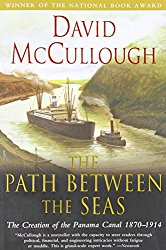
My interest in the book stemmed from a trip where I visited the Panama Canal, Panama, during my trip to Central America. I thought I should have a bit of history about the canal itself, and found that comprehensive books on the subject were a little tough to find. I ended up choosing The Path Between the Seas as the book showed promise, and the reviews on it were positive. What made me choose this book out of the others out there was the fact that the author discusses in his introduction that he wrote the book for the people who built the canal, and that the history he writes about is not the same as what you may have learned about.
So I went in with an open mind, and was shocked at the length of the book. It took me weeks to finish it (I don’t have that much spare time for reading), but I’m so glad I did.
While I’m glad I read the book, I will admit that there were times I felt anger about the author’s writings. I had to remind myself that the author merely put together pieces of history based on extensive research, and it was not the author’s fault to the actions of politicians and other money and power hungry players of that time.
The author did an excellent job of putting the facts together, which must have been scattered all throughout history. Yet he still managed to keep the story personally interesting regarding the main people in the book. The author was also honest when certain things couldn’t be verified, or when different sources provided two sides to a story.
The beginning of the book was a bit cumbersome and detailed, almost to the point that I would have generally stopped reading. After all, why do I need to know the name and character of every individual that played a part in the creation of the canal? I came to understand that character was a key point in this history. It was how media was skewed based on popularity, who had what financial interests, and what the general public was led to believe. I wrote led to believe not what they inherently believed because after reading this book, I realized how much influence the media has in influencing the general publics’ perception. What is written in newspapers can change the voting opinion of the masses, and that is exactly what happened with the Panama canal: the media of the time “sold” a certain narrative to the public, and that changed the course of history. It was interesting to read how easily the newspaper editors were swayed (some might refer to it as bribery and corruption today). It seems financial interest was what it was all about when the ideas of building a canal in Panama were first talked about. It was not relevant that it was nearly an impossible engineering feat. And the debate between locating the canal in Nicaragua versus Panama was an important one, with significant implications about who would benefit.
More than anything else, it was really the character of the people involved that made the canal happen. Many people today don’t know that construction of the canal was actually begun by the French. A significant amount of work was paid for by the French. It was later bought by the United States for a lump sum (at pennies on the dollar). Then billions of dollars more were invested to finish the project, and only because the US President at that time, saw the canal as providing the potential for better Naval warfare. Yep, warfare, not common or commercial good.
This book also offered a full picture of how Panama became independent from Colombia. An amazing feat itself, that only happened because all the chess pieces happened to be positioned just right.
It turns out that all those nitty gritty details at the beginning of the book were important to learn before one could understand the true undertaking that this project was.
There was an even more important lesson in this book than the amount of politics, money, and shenanigans it took to build such a project. And that was the amount of life it cost. The author did a lot of research in trying to get actual numbers of lives lost as a result of the canal. Numbers of lives during the French building era, and numbers lost during the US building era. Unfortunately, the bigot ways of that time disregarded people of darker skin tones to be less valuable than whites, and therefore, the true numbers of lives lost will never be known.
The different lifestyles, living conditions, food, and everything else, were described as consisting of two very different classes of workers. The whites, and the not pure whites. The happy times reported in all the papers in the US never mentioned the number of non-white workers doing the hardest, and most dangerous parts of the work. A job that most of the world now benefits from.
After reading the grandiose numbers of death due to disease and other incidents, I was expecting a monstrosity when visiting the actual canal. Instead, I was rather a bit disappointed. The canal itself, while an amazing feat of engineering that has provided a shortcut for ships to sail through, appeared much smaller in comparison to the deaths I had read about. There is currently an expansion project being completed, and in a way, what I saw in the expansion project is almost what I expected to see with the original canal.
Perhaps had I not read the history and all the sad factoids prior to seeing the actual canal, I may not have been as disappointed.
This book is a long read, and it is cumbersome at times, but it is an important piece of world history. The Panama canal was not just built by the United States, but many countries. And it benefits the entire world as well. The author, David McCullough did an incredible job in researching and recording the history, and his artistic writing style is well worth the read.
Nature's Complement is a participant in the Amazon Services LLC Associates Program, an affiliate advertising program. If you purchase products on Amazon through any of our affiliate links, we get a small percentage of the transaction, at no extra cost to you. We spend a lot of time writing the articles on this site, and all this information is provided free of charge. When you use our affiliate links, you support the writing you enjoy without necessarily buying our products. (However we would appreciate if you would do that too!) Thank you for helping to support our work, however you choose to do so.
These statements have not been evaluated by the Food and Drug Administration. This information and/or products are not intended to diagnose, treat, cure or prevent any disease.


